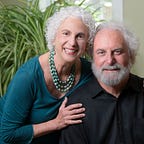From Fear to Fearlessness
Fearlessness is not an absence of fear; it is being committed to something bigger than the fear. That something can be another person’s safety, a higher purpose, a calling, or any other intention.
You may wonder why a book on relationships would be addressing the concept of courage. Anyone who has been in the trenches of committed partnerships knows that it takes more than sweetness to meet the challenges that love demands. Loving another person requires us to live with an open heart. The French root of the word “courage” is “Coeur”, from the Latin “Cor”, both of which mean “heart”. To live openheartedly requires great courage since we are vulnerable to loss, rejection, and pain.
When our feelings get hurt, it takes great courage to resist the temptation to become defensive and to instead become fearless. We can’t help but feel fear when we are threatened, but even in those difficult moments, we have the power to determine how we react. Acting from our deeper intentions rather than indulging our impulse to defend, withdraw or attack can pay off in long-term rewards. Whenever we make this choice, we strengthen our fearless muscle.
Fear is normal. Fear is not the enemy. We can’t get rid of fear; even if we could it would NOT be a good thing to do. Fear can alert us to possible dangers. Cultivating fearlessness does not mean that we no longer have fear, but that we have moved from fearing fear and avoiding anything that activates it, By accepting the inevitability of fear, we learn to appreciate its value. Fearlessness is the state of being in which we are aware of fear yet not controlled by it.
When we are possessed by fear, we’re unwilling to take risks, which can be a good thing, since some risks would be unwise. When we live in a state of ongoing anxiety, our primary commitment is to avoid pain or loss. There are some risks that are worth taking if we seek to experience fulfilling lives. The old cliché states, “The only constant in life is change.” And change isn’t guaranteed to be for the better. We can try to minimize the risks involved in the inevitable changes that life brings, but if we don’t become friends with fear, our lives can become stagnant.
Risk-taking is something that if done with discernment, supports our ability to learn from our mistakes. As we correct our errors, we are better prepared for future challenges. If we don’t risk, we don’t learn and grow.
Rather than being guided by the question of “What is the safest thing to do in this situation? we can ask ourselves the questions, “What is it that I truly want to experience now?” Cultivating fearlessness is about redirecting the focus of our attention from away fear and towards desire. This is not to say that we ignore fear, but simply that we subordinate it to our commitment. Doing so puts fear in its rightful place. It is still in the equation, but it is no longer the determining factor.
Often it’s not that we have too much fear; we don’t have enough of it, and we’re afraid of the wrong things. Many people reach the end of their lives with regrets. Often, their regrets are not about mistakes they made, but about what they wish they had been willing to risk.
When we trust ourselves to survive our mistakes, to learn from them, we put in the corrections that will affect our future actions. We feel less fearful since we have established greater trust in ourselves that we can handle the failures and disappointments that occur in all well-lived lives. Trying to avoid discomfort weakens us and makes us more fearful. Reawakening the curiosity that we had as children helps us know fear intimately. As we become familiar with fear, we come to be less averse to it and see it as an intrinsic aspect of the process of coming to terms with our deeper values.
Resistance, control, rage, and resignation are all defenses against fear. Any form of manipulation, lying, avoiding, denying, withdrawing, withholding, or defensiveness, strengthens fear. In cultivating fearlessness we are challenged to do the opposite of these things, to confront that which we have been avoiding.
The process of becoming fearless has to do with the development of self-care, self-responsibility, self-compassion, and self-trust. It also requires us to cultivate the quality of forgiveness, not just for others, but also for ourselves, the person who is often the hardest to forgive.
Many of us view the world as a dangerous place where it would be foolish to let down our guard. Granted, there are people to whom it would be very unwise to give our trust, but there is also a grave danger in bringing a stance of suspicion to every encounter. Such a posture predisposes us to justify dishonesty hypocrisy and irresponsibility.
Confronting fear requires experiencing both our aversion as well as our desire, and to engage both sides directly. If desire is strong and the expected rewards are high, we can commit to going forward even in the face of fear. This is truly “warrior work” and it’s not for the faint of heart. We don’t necessarily begin with a brave heart; we develop it along the way. We begin wherever we are right now and just put one foot in front of the other and repeat, and repeat, and repeat.
We’re giving away 3 e-books absolutely free of charge. To receive them, just CLICK HERE. You’ll also receive our monthly newsletter.
